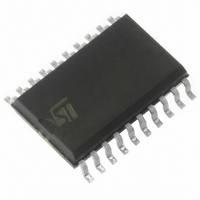TDA7403D STMicroelectronics, TDA7403D Datasheet - Page 14

TDA7403D
Manufacturer Part Number
TDA7403D
Description
IC PROCESSOR BASIC SIGNAL SO-20
Manufacturer
STMicroelectronics
Type
Car Signal Processorr
Datasheet
1.TDA7403D.pdf
(25 pages)
Specifications of TDA7403D
Applications
Automotive Systems
Mounting Type
Surface Mount
Package / Case
20-SOIC (7.5mm Width)
Lead Free Status / RoHS Status
Lead free / RoHS Compliant
Available stocks
Company
Part Number
Manufacturer
Quantity
Price
Part Number:
TDA7403D
Manufacturer:
ST
Quantity:
20 000
Part Number:
TDA7403D.
Manufacturer:
ST
Quantity:
20 000
TDA7403
by reading the status byte of the TDA7403 via
I2C bus.
Fieldstrength Control
The fieldstrength input is used to control the high
cut and the stereoblend function. In addition the
signal can be also used to control the noise-
blanker thresholds.
LEVEL Input and Gain
To suppress undesired high frequency modula-
tion on the highcut and stereoblend function the
LEVEL signal is lowpass filtered firstly. The filter
is a combination of a 1st order RC lowpass at
53kHz (working as anti-aliasing filter) and a 1st-
order switched capacitor lowpass at 2.2kHz. The
second stage is a programmable gain stage to
adapt the LEVEL signal internally to different IF.
The gain is widely programmable in 16 steps
from 0dB to 10dB (step = 0.67dB). These 4 bits
are located together with the Roll-Off bits in the
"Stereodecoder Adjustment" byte to simplify a
possible adaptation during the production of the
carradio.
Stereoblend Control
The stereoblend control block converts the inter-
nal LEVEL voltage (LEVEL INTERN) into an de-
modulator compatible analog signal which is used
to control the channel separation between 0dB
and the maximum separation. Internally this con-
trol range has a fixed upper limit which is the in-
ternal reference voltage REF5V. The lower limit
can be programmed to be 33%, 42%, 50% or
58% of REF5V (see fig. 16).
To adjust the external LEVEL voltage to the inter-
nal range two values must be defined: the LEVEL
Figure 16. Relation between internal and external LEVEL voltage and setup of Stereoblend
14/25
VOLTAGES
INTERNAL
REF 5V
VSBL
VMO
SETUP OF VST
VST
LEVEL
FIELDSTRENGHT VOLTAGE
t
LEVEL INTERN
VSBL
VOLTAGES
INTERNAL
the full channel separation is reached (VST) the
LEVEL gain L
equation can be used to estimate the gain:
Figure 15. Internal stereoblend characteristics
gain L
The gain can be programmed through 4 bits in
the "Stereodecoder-Adjustment" byte.
The MONO voltage VMO (0dB channel separa-
tion) can be choosen selecting 33, 42, 50 or 58%
of REF5V.
All necessary internal reference voltages like
REF5V are derived from a bandgap circuit.
Therefore they have a temperature coefficient
near zero. This is useful if the fieldstrength signal
is also temperature compensated.
But most IF devices apply a LEVEL voltage with a
TC of 3300ppm. The TDA7403 offers this TC for
the reference voltages, too. The TC is selectable
with bit D7 of the "stereodecoder adjustment"
byte.
REF 5V
58%
50%
42%
33%
D97AU639
L
G
G
and VSBL. To adjust the voltage where
Field strength voltage [STEREO]
SETUP OF VMO
VMO
G
has to be defined. The following
VST
REF5V
LEVEL INTERN
FIELDSTRENGHT VOLTAGE
t













